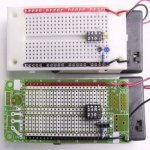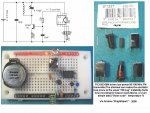hippy
Ex-Staff (retired)
There have been a few posts from people new to electronics, micros or the PICAXE itself ( of a wide range of ages ) who have wondered how best to start out and what they need. One important thing I think is, "something to do with it", once they've got it.
The education sector sorts itself out in the classroom and most people attracted to the PICAXE have some idea of what they'd like to use it for eventually, but I think it would still be a good idea to have some beginner projects which can be used to lead people through actually using the PICAXE and what they've bought. The main criteria being that it's ( reasonably ) simple, cheap to do, worthwhile and fun.
Whether they are simply ideas to jump off from or become full tutorials or step-by-step examples would depend upon what effort people would care to put in. Just the ideas is a good starting point. If there is anything which fulfils this area which I've missed please do give links to them. Educators with experience could give valuable input here.
I'd like to take the useful ideas and turn them into a sticky or copy them to one of the sub-forums where they can be easily be pointed to and found.
My suggestion is a traffic light, add a piezo and a button and that becomes a pedestrian crossing. That covers most basic interfacing and control, and can even get quite complex. It's where I'd start if I were leading someone through the PICAXE.
The education sector sorts itself out in the classroom and most people attracted to the PICAXE have some idea of what they'd like to use it for eventually, but I think it would still be a good idea to have some beginner projects which can be used to lead people through actually using the PICAXE and what they've bought. The main criteria being that it's ( reasonably ) simple, cheap to do, worthwhile and fun.
Whether they are simply ideas to jump off from or become full tutorials or step-by-step examples would depend upon what effort people would care to put in. Just the ideas is a good starting point. If there is anything which fulfils this area which I've missed please do give links to them. Educators with experience could give valuable input here.
I'd like to take the useful ideas and turn them into a sticky or copy them to one of the sub-forums where they can be easily be pointed to and found.
My suggestion is a traffic light, add a piezo and a button and that becomes a pedestrian crossing. That covers most basic interfacing and control, and can even get quite complex. It's where I'd start if I were leading someone through the PICAXE.


